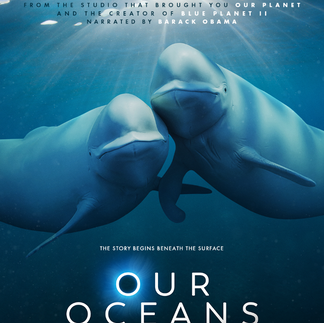Our Oceans - Bringing South African marine stories to a global Netflix series
- Animal Ocean
- Feb 19
- 3 min read
Back in 2020, I was invited by Jonathan Smith to join the creative team for a groundbreaking natural history series called Our Oceans. This was both an exciting and daunting opportunity, as the series aimed to tell compelling, character-driven stories about the five major ocean basins: the Southern, Indian, Atlantic, Pacific, and Arctic Oceans. While I initially felt uncertain about my ability to contribute amidst such a talented team, the journey of brainstorming and developing ideas proved to be incredibly rewarding.

Collaborating closely with Jonathan and his creative team, we held Zoom meetings to pitch ideas, discuss story concepts, and map out the sequence of events for the series. The focus was to craft narratives with twists and turns that went beyond simple spectacle, engaging viewers in the intricate lives of ocean creatures.
The series followed the journey of ocean currents through each basin, and my expertise naturally lay in the South African waters, encompassing the Indian and Atlantic Oceans. However, I was also able to contribute ideas for other regions, ensuring the stories were rich and diverse. Over the next few years, I worked on a series of shoots providing underwater support, logistics, some extra footage / timelapses, and boating to support cinematographers Roger Horrocks, Grant Brokenshaw, and Ted Giffords as they captured breathtaking sequences for the series.
One of the most challenging aspects was finding nuanced, character-driven stories with multiple layers. For the Atlantic, I proposed exploring the intricate wave vortices near Cape Town, a phenomenon brought to the world through the still images of Sacha Specker —otherworldly, fleeting phenomena that require high-speed cameras to film. These micro-moments, lasting less than a second, added a surreal and alien-like quality to the Atlantic Ocean sequence. Roger Horrocks, guided by Sacha , successfully captured these mesmerizing visuals, creating a recurring motif throughout the series.
The Sardine Run was another iconic topic we tackled. Filming this spectacle on the Wild Coast was immensely challenging, but the final sequence turned out beautifully, weaving together footage from our drone work, Roger Horrocks’ underwater shots, and contributions from other team members. The sequence effectively illustrated the impact of ocean currents on this incredible natural event.
One sequence I’m particularly proud of is the Steentjie Super-dad story, which focuses on a small, often overlooked fish found around Cape Town. Capturing their intricate nesting behavior in False Bay was a passion project of mine. Initially, it was hard to convey how captivating this story could be until researcher Nina Faure Beaulieu shared footage showcasing their behavior. This visual aid allowed me to pitch the idea to the team, and it became a highlight of the Atlantic episode (I'm biased), highlighting the fascinating lives of these easily overlooked fish. I’ll share more about this in a future post.
Working closely with Roger Horrocks and the talented creative team at Wildspace was an absolute privilege. I am incredibly proud of what Our Oceans has brought to the global stage—showcasing South Africa’s natural beauty and marine life.
Special thanks to Nadia, Kirsty, Katie, Jonathan, Abraham, Joe, Nick, Aiden, PJ, Rob, Nick, Andrea, Ken and everyone involved in creating this series. These behind-the-scenes moments reflect the dedication and passion that went into bringing this remarkable story to life. South Africa can truly be proud of it's contribution to Our Oceans.











Comments